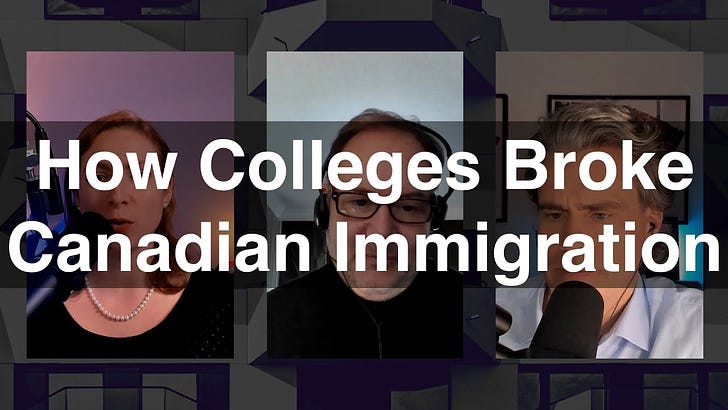Ontario colleges flooded the system
Alex Usher on the Missing Middle podcast with Cara Stern and Mike Moffatt
Alex Usher is president of the consulting firm Higher Education Strategy Associates, and he's got a super-informative blog. He’s been talking about the staggering number of international students at Ontario colleges for quite a while.
Ontario colleges: international students up, Aboriginal students down (October 2019)
Ontario doubles down on dodgy colleges (November 2019)
Where the living is easy (January 2020). Ontario colleges are getting a huge amount of revenue from international students. "My jaw is still on the floor. This can't possibly end well."
The bill is coming due (May 2023)
The bailiffs are at the door (June 2023)
A short explainer of Public Private Partnerships in Ontario colleges (September 2023)
Caps on student visas (September 2023)
Lack of foresight
In June, I told a group of university business officers that I thought Armageddon on student visas was coming in the next eight months. I then asked how many of them had a GR or financial strategy that covered that possibility. Zero hands went up.
Was nobody reading his blog?
Mike Moffatt:
Yup. I talked to a few schools (though not nearly as many as Alex), and they all dismissed my concerns that something like this was coming. All of them.
Ontario responses
In Usher’s most recent post, he describes Ontario’s announced policy responses:
They are all spectacularly beside the point because none of them provide any clarity—or even any indication of a path leading to clarity with respect to how the province is going to distribute visa processing spots between institutions. And yet this is the only thing that matters to institutions now. Visa processing is in moratorium until provinces work out their system of allocation capped spots. In comparison to that, everything on the province’s list is a distraction. It’s meant to show that the province is “doing something” and hoping to God no one notices that the “something” isn’t actually relevant.
And:
So, all of this is bad, certainly, but it’s arguably not as bad as Colleges Ontario’s 1326-word statement responding to the federal changes, which is a masterclass in failing to read the room. Go on, read it. Utterly self-centered, all about protecting their revenue schemes, no sense whatsoever that the whole reason this scenario is occurring is that they lost social license to keep bringing in more international students and that the public has serious (albeit not necessarily well-founded) views about the quality of PPPs and the quality assurance. Tone-deaf is putting it mildly.
(Also: I am taking bets on when the rest of the sector decides to throw Conestoga under the bus for ruining the international student thing for everyone else. Issuing acceptances for 34,000 study permit students in 2023 alone—in a city with under 400,000 students—was an absurd cash-grab with no thought as to impact on the local community. As soon as the distribution of spots starts, you know the other colleges are going to argue hard against Conestoga getting a share of 2024 visas based on its 2023 share. Should be amusing.)
International-student fees as a subsidy for local economies
An interesting comment from Reddit, suggesting Ford’s motivation for “dumping gasoline on the housing fire” in the GTA (as Usher puts it) by expanding public-private partnerships and then international student numbers: Ford has basically been using international-student tuition to subsidize the economy in places like Timmins. Not the students themselves (they’re in the GTA), but their tuition fees.
It's a big issue for Ford. He has general disdain for universities, but the colleges are the largest employer in a bunch of Conservative seats.
There will be a lot of suffering in towns like Timmins, Sarnia, Belleville, and North Bay if their colleges have to shrink or close. What replaces international students in the Timmins economy if that multi-million revenue stream dries up?
From the Missing Middle podcast, Usher describes the money involved in Ontario’s public-private partnerships, where a public college licenses its curriculum to a private college based in the GTA:
Most public colleges are charging $15, $16, $18,000 in international tuition, and the public college pays a flat fee to the private college for teaching them. And we have no idea what that number is, because those contracts are secret. My guess would be they're being charged about $10,000 a student, and so the net on that is probably about $5,000 a student. $4 or $5,000, that's kind of the range. For not teaching anybody.
If I'm a college like Northern and I've got 7,500 students at any given time - that's not necessarily per year because some of these students are on 8-month programs. So they may have only 7,500 at any given time, but that could still equal as many as 11,000 in a year. You know, $4,000 a pop, that's $44 million. That's equal to their entire budget five years ago.


